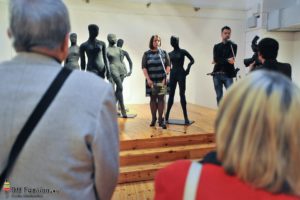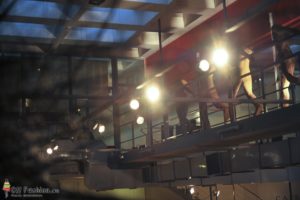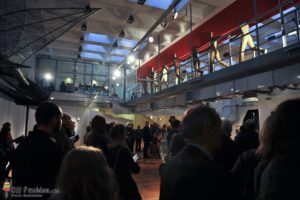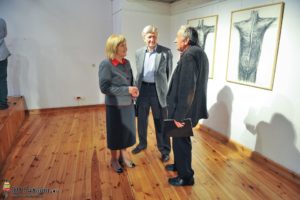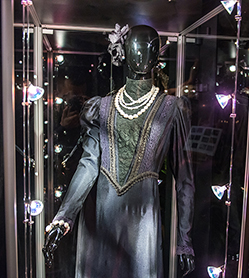Wystawy
Exhibition of works by Prof. Magdaleny Abakanowicz opening 15 May 2014, at 6.00 pm

Magdalena Abakanowicz
Born in 1930 to a noble landowner family in Falenty.
In 1954, she graduated from the Academy of Fine Arts in Warsaw.
Looking for own her reality, she paints large colourful gouaches on paper and canvas. They are imaginary, visualised shapes of plants, fish, insects. Spaces controlled by no-one but herself evoke the need for the third dimension. She turns to weaving that, subject to interpretation and modification, gives her flexible organic matter out of which she can form three-dimensional shapes. She collects old ropes, makes up her own technique of weaving. She creates surfaces with strong relief effect and structures, raised openings and cracks. She uses that material to shape monumental objects. The extraordinary sculptures were named Abakans, because there had never been anything similar in the art before.
In 1965, she takes the Grand Prix at the Sao Paulo Biennale. Her works are exhibited in museums in Europe, and thereafter in America, Australia and Japan. Each exhibition is a separate work, she builds new spaces and new forms out of the existing ones. She divides the space with a rope that is being unreeled from a big wooden circle.
In 1972, the human being becomes her model. Cast of human shape, impressed in canvass taken from old hemp sacks. This material speaks about modern times, human condition. In her imagination, she sees crowds of human figures, headless, stretching to the horizon. Major cycles are created: Back, a group of eighty, Sitting Figures, a group of seventeen, Standing Figures, a group of fifty. Then, children come to her studio. Ragazzi, Infantes, Puellae, Bambini are created – about one hundred various figures.
In 1976, her works are exhibited at National Galleries of Melbourne and Sydney. In speeches she delivers at congresses and universities, she speaks: A crowd of people, birds, insects, or leaves is a mysterious assemblage of variants of certain prototype. A riddle of nature’s abhorrence of exact repetition or inability to produce it. Just as the human hand cannot repeat its own gesture, I invoke this disturbing law, switching my own immobile herds into that rhythm.
In 1980, at the 1980 Venice Bienniale, being an occupant of the Polish pavilion, she draws attention of art critics from all over the world. Grand Prizes were abandoned for 10 years. However, according to critics, the Polish artist would have won the Grand Prix if it had been in existence.
The Museum of Modern Art of the City of Paris organizes her solo exhibition. Thereafter, she has retrospectives in seven museums in America.
The Metropolitan Museum of Art in New York shows her works. A cycle of exhibitions is held in Japanese museums. In Japan, a foundation named after her name is established that organises speeches. There, an idea of dances deriving from her sculptures is thought up. It is followed by performances of Japanese and Polish dances in Hiroshima, Tokyo and Warsaw in 1994 and 1995.
At the beginning of the 90’s, she enters an architectural contest for extension of the Historical Axis of Paris. She designs a cycle of houses – vertical gardens, organic structures with facades completely covered in green that would have been a new entrance to the city. Arboreal Architecture project was decided to be pursued, yet it was abandoned following President François Mitterrand’s death.
The Artist wishes to see her works in a space open to the light and landscape, she builds spaces to contemplate.
In 1985, Katarsis is created in Spazi d’Arte foundation, Giuliano Gori, Italy. It is a field populated with rows of 33 bronze figures, about 3 metres high. In 1987, she arranges seven large stone circles in the Negev Desert for the Israel Museum, Jerusalem. All circles, weighing about 12 tons each, are placed in an irregular row at an escarpment in the Art Garden within the Israel Museum.
In 1988, she creates ten metaphoric animal heads, cast in bronze in Korean foundries for Olympic Park in Seoul. She also works at foundries in Italy, America, Japan and Germany.
The spaces to contemplate are to include Space of Unknown Growth of 2000, built of hand-laid concrete: it comprises twenty-two four and five-metre- high structures resembling haystacks or boulders. They are placed in a forest near Vilnius, as if they would have stood there since the beginning of time. Another important composition is the Space of Stone for Grounds for Sculpture, Hamilton, New Jersey, USA – 22 granite stones having a cracked structure.
She changed her sculpture from a single object into a space of experiences. Independently, large groups of figures are created. Groups of figures, and namely signs, warnings, cautions meet people in museums, collections, landscapes. There have been more than a thousand of them, however, they have never been seen together.
he most important ones include Unrecognized, a hundred and twelve iron-cast figures, each more than two metres high, displayed as a permanent installation at Citadel Park in Poznań in 2002, and Agora, a group of a hundred and six monumental iron-cast figures, permanently installed in Chicago’s Grant Park. They are metaphors speaking about the human condition, about a headless crowd that hates or adulates as instructed. They spell reality.
Abakanowicz travels, always being a director of her creation that every time becomes, as a group of meanings, an important story to tell.
She has a home and lives in Poland. At the same time, she puts her visions into practice in a number of countries.
W związku z bardzo dużym zainteresowaniem wystawą Magdaleny Abakanowicz wystawa zostaje przedłużona do 2 lipca 2014 r.
Relacje z wystawy
 return
return
































